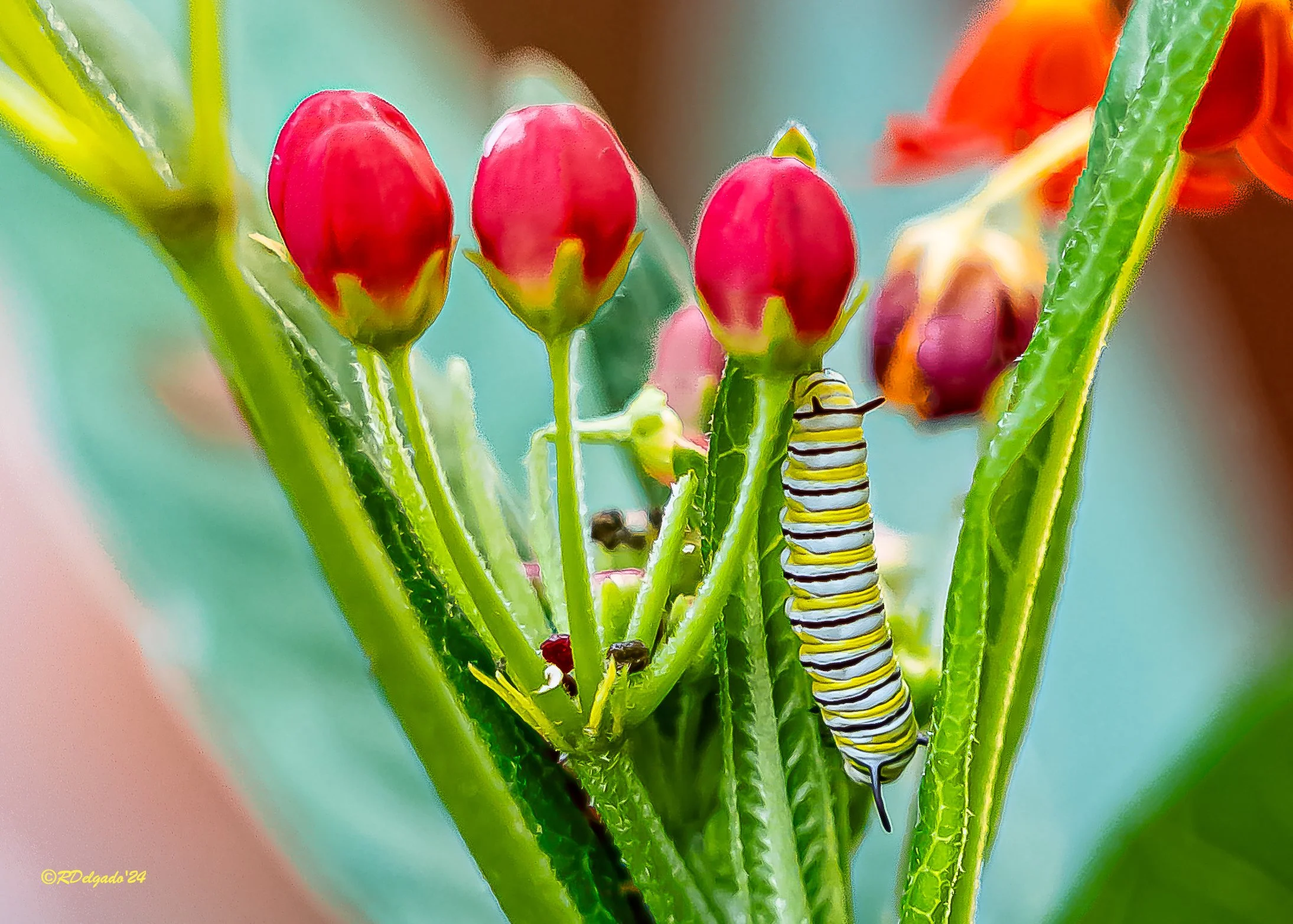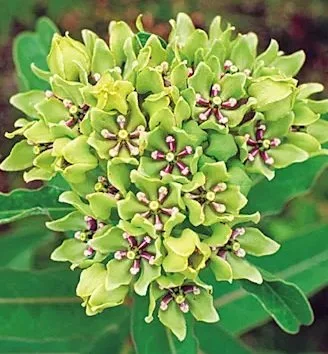A monarch butterfly can travel up to 3,000 miles. Adult monarch butterflies that hatch in late summer or early fall do not mate or lay eggs. Their only job is to migrate south to roosting grounds where they will spend the winter.
Adult monarchs consume a great deal of food during their migrations. That’s why it is important to provide both nectar plants that bloom all summer long and more important nectar plants that bloom in the fall for the southern migration. Here is a list of annual nectar plants that monarchs really like and tolerate full sun: Cosmos, Lantana, Marigold, Mexican sunflower, Starflower, Verbena and Zinnias.
Monarch caterpillar. Photo by Robert Delgado.
The most important plant to have in your garden to help monarch butterflies is milkweed. Better yet, have two or more species of milkweed plants so that they bloom at different times. Monarch caterpillars will devour and defoliate a milkweed plant. But that is the point; milkweed plants are resilient and will recover in two-three weeks.
Remember: All plants in the genus Asclepias are probably somewhat toxic, to both humans and animals. The sap of some milkweeds causes skin irritation in humans. Sensitivity to a toxin varies with a person’s age, weight and physical condition. But it is these same toxins provide a benefit to the both caterpillars and butterflies. The toxic compounds are distasteful and induces vomiting in birds and other predators. Since caterpillars feed exclusively on the toxic leaves and the milky juices of milkweeds, these toxins are absorbed in the bodies of caterpillars and the resulting adult butterflies.
There are 30 species of milkweeds that are native to Texas. These native milkweeds are diverse in growth habits, soil, sunlight and moisture preferences in the nine plant hardiness zones of our state. Below is a short list of the Texas native milkweed plants that do well in the Houston region and where to buy seeds and plants.
Butterfly weed
Asclepias tuberosa has bright orange fragrant flower clusters that bloom June to September. They grow 1-3 feet tall, like full sun and have bright orange flower clusters 2-5 inches wide. It actually has no milky sap, despite being considered a milkweed. Flowers do not usually appear until the plant is well-established. The butterfly weed is a host plant for Grey Hairstreak, Monarch and Queen butterflies. It also provides a nectar source for bees, butterflies and hummingbirds.
Butterfly weed.
Green milkweed
Asclepias virdis has white to green flower clusters that bloom May to August. It can grow 18-24 inches tall and likes full sun and moist soil. This is the most common milkweed in Texas, ranging from deep East Texas to the Edwards Plateau. The Green milkweed is a host plant for Monarch, Queen and Soldier butterflies. It also provides a nectar source for bees and numerous butterfly species.
Green milkweed.
Swamp Milkweed
Asclepias incarnata has deep rose-pink flowers that bloom June to October. It grows in wet soils at the edge of streams and ponds. It can grow to five feet tall with shallow roots. It likes full sun to part shade and wet soil. Can be found from east Texas to Edwards Plateau. Swamp milkweed is a host plant for Monarch and Queen butterflies. It also provides a nectar source for bees, butterflies and hummingbirds.
Swamp milkweed.
Tropical Milkweed
Asclepias curassavica is the most often sold milkweed at garden centers. While not ideal, be aware that Tropical milkweed is a non-native milkweed and plant them with caution. This milkweed can stay leafy late into the fall or through the winter (in moderate climates) and that is not good for monarch butterflies for two reasons.
First, this will cause monarchs to linger too long and lay eggs that hatch too late to make the southern migration. For this reason, Tropical milkweed should be cut down close to the ground in late September. In fact, it should be cut down twice during the growing season due to the second issue.
Second, Tropical milkweed can harbor a parasitic spore that is deadly to monarch butterflies. Ophryocystis elektroscirrha or OE for short, can travel with monarchs visiting the plants and become deposited on leaves. When caterpillars hatch and start eating the plant, they ingest the OE. High OE levels in adult monarchs have been linked to lower migration success in the eastern monarch population, as well as reductions in body mass, lifespan, mating success, and flight ability.
Native milkweeds do not have parasitic spore issues because they die back after the growing season, the parasite dies along with them so that each summer’s monarch population feeds on fresh, parasite-free foliage. In contrast, because Tropical milkweed that remains evergreen longer this will allow OE spore levels to build up on the plant over time. Thus successive generations of monarch caterpillars feeding on the plant can be exposed to dangerous levels of OE.
In short, it is best to plant Texas native milkweeds instead of Tropical milkweed. But if you have Tropical milkweed you can reduce it’s harmful effects on monarch butterflies by cutting it down close to ground twice during the growing season.
Tropical milkweed. Photo by Robert Delgado,
Where to buy native milkweed seeds and plants:
Butterfly Bushes butterflybushes.com
David’s Garden Seed davidsgardenseed.com
High Country Gardens highcountrygardens.com
Prairie Moon Nursery prairiemoon.com
Prairie Nursery prairienursery.com
Seed Source seedsource.com
The Xerces Society xerces.org/milkweed-seed-finder
Monarch caterpillar. Photo by Robert Delgado.





